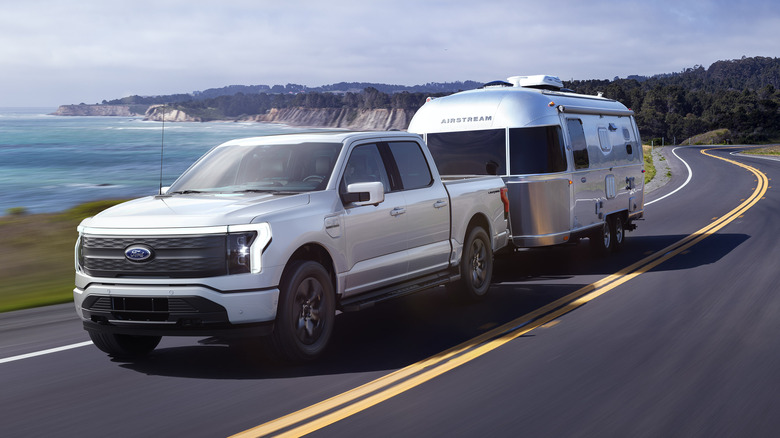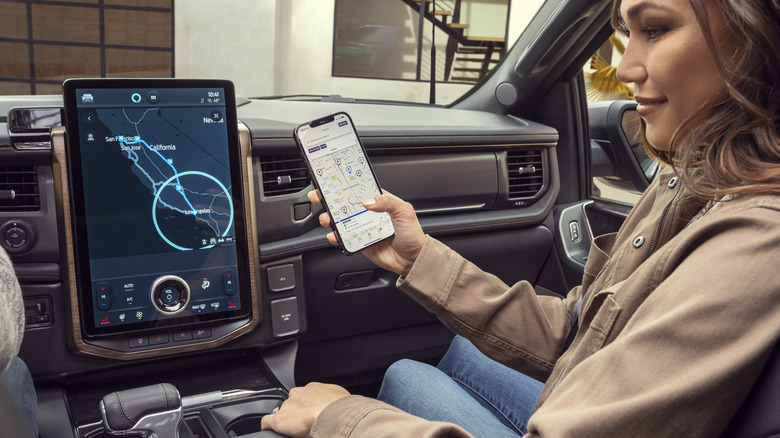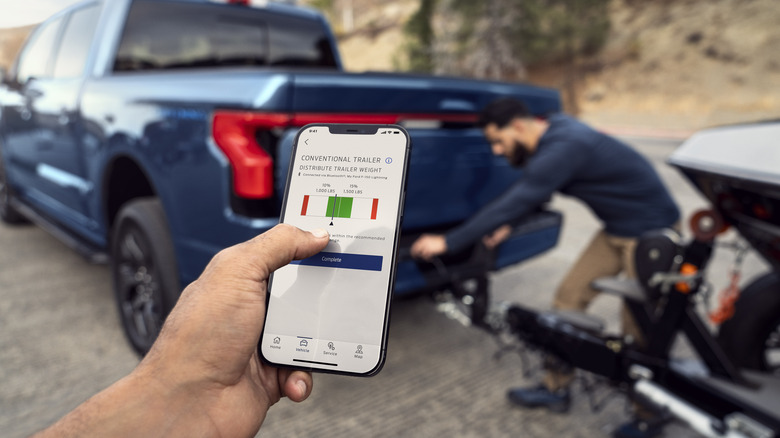3 Smart Ways The Ford F-150 Lightning Tames EV Range Anxiety
Ford's F-150 Lightning may be rated to tow up to 10,000 pounds, but the weight of range anxiety on drivers is even more of a challenge as the all-electric truck finally nears dealerships. After all, just about every EV owner knows what it's like to stare at the range estimate on the dashboard, and wonder if there'll be enough charge to make it to their destination.
The challenge is arguably even greater when you take into account activities like towing: an ability most truck owners take for granted. It's yet another set of difficult-to-predict variables heaped on top of the overall calculation for range, and the stakes are no less serious. After all, nobody wants to be stranded at the side of the road with a flat battery and an unmovable load hanging off the back of your pickup.
Ford has already confirmed the EPA range figures for the F-150 Lightning, with the electric truck rated for up to 320 miles of driving depending on exact trim and battery size. The EPA tests, however, don't take into account the impact of towing a load behind an EV. Instead, Ford is using some clever hardware and software — as well as the collective wisdom of the crowd — to try to make things more transparent for F-150 Lightning drivers.
1. The F-150 Lightning learns over time
Whether it's a gas vehicle, a hybrid, or a purely-electric one, every driver knows that the official economy estimates are just that: estimates. Exactly what sort of figures you'll actually get are dependent on how you drive, the sort of terrain you tackle, and many other factors.
The F-150 Lightning will attempt to take that into account. Dubbed Intelligent Range, the feature effectively monitors how your specific driving impacts the overall range available from the battery. That includes traffic speed, the ambient temperature outside, how much battery energy is available, your driving style, how you set the climate control in the cabin, and even route topography. The more you use the pickup, the more data it gathers and — Ford says — the more accurate its predictions get.
2. Ford compares your driving with other EV owners
Intelligent Range isn't just limited to a single EV, however. Ford also uses the F-150 Lightning's connectivity to link the truck to the cloud. That allows it to share information on how all those individual factors effect total driving range, and build more comprehensive profiles.
It's the idea of more data increasing overall accuracy. Ford can compare the results from similar vehicles operating in similar situations — say, an F-150 Lightning with the standard battery, towing a 2,500 pound trailer, on mostly flat roads in the Midwest — to better shape the range estimate that shows on the dashboard in your particular truck.
That should mean more accurate numbers, even if you're tackling a situation that's completely new to you. Intelligent Range can pull in data from other drivers who have already faced real-world factors like those you'll be facing, to make your own individual estimates more relevant. Ford has already used that for the Mustang Mach-E, but it could be even more useful for the F-150 Lightning.
3. Smarter sensors take into account what you're using your truck for
On top of the existing data that Ford is using to give Intelligent Range its insight into driving, the F-150 Lightning also adds some new metrics for the math to chew on. Ford Onboard Scales is an option on the new EV, effectively turning the truck's bed into a huge set of measuring scales. That's useful when you're loading up since you can see — from the Ford app, and by using the taillights as an LED load indicator — how close you're getting to the maximum payload rating.
With that number shared with Intelligent Range, however, it can also be baked into the overall range calculation. How and where you're driving is also a big factor: at lower speeds, cargo and trailer weight have bigger impacts on range degradation, Ford says. At higher speeds, meanwhile, it's the aerodynamic profile of the vehicle — effectively how slippery it is for the air to flow across it — which is the main criteria.
Telling the F-150 Lightning exactly where you plan on going, then, plays a big part in that. Power My Trip works with the EV's route planner, and with data programmed in about just what sort of thing you're intending to tow, to work out just how far you can go between charges. If you're not going to have enough power, it'll also suggest places to stop along the way to recharge.
Production of the F-150 Lightning has already begun, with deliveries of the all-electric truck expected to start imminently.


